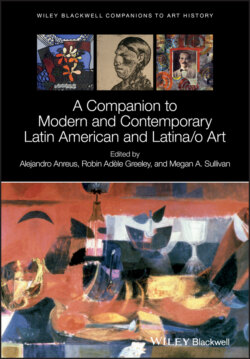Читать книгу A Companion to Modern and Contemporary Latin American and Latina/o Art - Группа авторов - Страница 22
1.2.1 Diego Rivera
ОглавлениеRivera is the best known and most productive of the Mexican mural painters. He presented himself as the leader of the muralists and this myth was accepted to the detriment of dozens of other important painters.
Rivera had been in Europe, mostly in Paris, from 1907 to 1921 and was called back by the government to initiate the visual arts program. Before his return to Mexico, Rivera took a trip throughout Italy in order to study examples of mural painting from the Renaissance. There he learned lessons of large‐scale composition, such as how to arrange many figures in landscape and architectural settings, how to organize the important episodes of a historical narrative, and how to master the technique of fresco.
For his first project under Vasconcelos, however, in 1922, Rivera chose the medium of encaustic. This was the mural painting titled La creación (The Creation) (illustrated in Rodríguez 1969, p. 169, and Rochfort 1993, p. 34), located in the National Preparatory School in Mexico City. It was painted on the rear of the stage of the auditorium, directly facing the audience for lectures and performances.
At the bottom of both corners, we see nude brown‐skinned figures, a woman and a man respectively. Behind and above them are many colorfully dressed figures whose role is to educate these Mexican Indians, Adam and Eve, as it were, according to the dictates of European knowledge. The primitive and culturally “empty” indigenous Mexicans would be molded into civilized, Europeanized citizens, to be clothed in finery and taught to recite poetry. They would become a hybrid race, brown on the exterior, white inside. This meaning is in line with Vasconcelos' own ideas on the subject, which he articulated in his book La raza cósmica (The Cosmic Race), in 1925, of a race that “would form a type infinitely superior to any previous ones …, the lower forms of the species will be absorbed by the superior one.”1
Although generally realistic in style, this mural also hints at cubism in some details, the traces of Rivera's time with Picasso in Paris (see Favela 1984).
Another key image painted for Vasconcelos, in the headquarters for the Ministry of Public Education in Mexico City, is the fresco panel titled El maestro rural (The Rural Teacher) (illustrated in Rodríguez 1969, p. 210, and Rochfort 1993, p. 55), completed in the period 1923–1924, during which Rivera produced images more in line with contemporary issues and with his own increasingly leftist politics, depicting real Mexicans in local costume and recognizable landscapes.
We see a barren landscape where campesinos (peasants) till the land, build a simple structure, and sit in a circle with a teacher who holds an open book. A mounted guard scans the countryside, rifle at the ready. At this time, the government was under attack by counterrevolutionaries who targeted the “socialist” rural school. This painting gives equal importance to various kinds of constructive labor. One of Vasconcelos' slogans at this time was to join “working brains” with “working hands” (Vasconcelos 1950, pp. 23–25). The work to produce food from the land, to construct housing, to “plant” and to “grow” knowledge, and to defend these with arms all fall within the vested interest of the government to advertise its programs and to survive political and militant challenges to its rule.
In this context, a quotation from an official publication of the Ministry at this time is relevant. It stresses “cooperation in social life as a means of awakening a spirit of fraternity and mutual service which is the preparation of a future social order” (Secretaría de Educación Pública 1923–1924, pp. 294–295). Notice how the circle of students offers an opening where a hat lies on the ground. This is clearly an invitation for the viewer to be absorbed into this circle, to join this “future social order.” The history lesson and its moral implications point both to the past and to the future, characterizing the present regime as the crucial agency of an enlightened and free society. As one writer of the day responded to this painting, “Perhaps the best symbol of Mexico today is the vigorous fresco of Diego Rivera, in which…the rural teacher is shown surrounded by children, poorly dressed as herself, but animated with a vision of the future” (Enríquez Ureña 1925, p. 35).
